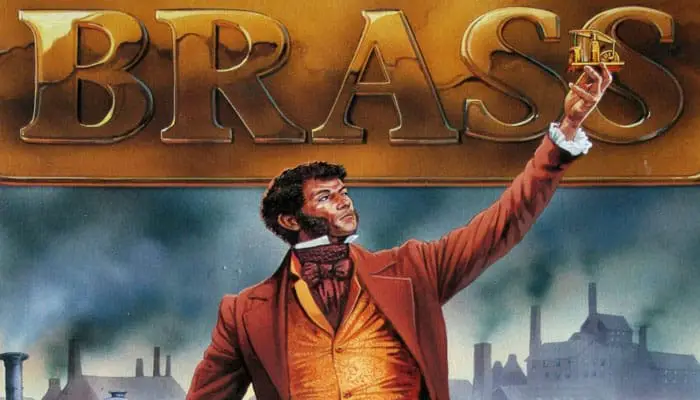
Game Components

- 1 Gameboard
- 1 Rulebook
- 4 Counter sheets
- 8 Player wooden discs
- 66 Cards
- 30 Black coal cubes
- 25 Orange iron cubes
- 1 Black marker
- 100 Plastic coins
- 7 Plastic storage bags
- 12 Distant Market tiles
- Each player should have:
- 12 Cotton Mill counters
- 8 Port counters
- 7 Coal Mine counters
- 6 Shipyards counters
- 4 Iron Foundry counters
- 14 Canal/Rail counters
- 2 Victory Point counters
- 2 Wooden discs
Setup
Each player should select a set of counters and wooden discs. Each player should place one of their wooden discs on the £0 space of the Income/VP track.

You should keep your Victory Point (VP) counters to one side as they will not be needed until the end of the first period.
You must arrange your Industry counters into piles of the same type. In each pile the counters should be ordered by Tech Level, with the lowest Tech Level on top and the highest Tech Level at the bottom.

EXAMPLE: When arranging your cotton mills you must make sure all of the Tech Level 4 mills go at the bottom, with the level 3 mills on top of them, then the level 2 mills, with the level 1 mill on top of the stack.
Place one black coal cube in each space on the Coal Demand track. Place one orange iron cube in each space on the Iron Demand track. Place the remaining cubes by the side of the board to form a stock. Place the black marker on the top space of the Cotton Demand track.
Shuffle the Distant Market tiles and place face down in the space marked 'Distant Market Tiles'.
Randomly determine the first player in a manner of your own choosing. The order of play should go clockwise from that player in the very first turn. Mark the order of play on the Player Order display, using a wooden disc from each player.

The plastic money counters should be placed in a bank by the side of the board. Each silver counter is worth £5, while each copper counter is worth £1. Each player starts with £30. You are now ready to start playing the game.
Game Play
The game is divided into two periods, the Canal Period and the Rail Period. Each period consists of the following phases:
- I. Cards
- II. Player actions
- III. Victory Points
- IV. New Period
The game will end at the end of the Rail Period.
Phase I. Cards
Shuffle all of the cards together. Deal out eight cards to each player. Now remove the following number of cards from those remaining inthe deck:
Four Players - in the Canal Period remove 6 cards, in the Rail Period remove 2 cards.
Three Players - in the Canal Period remove 9 cards, in the Rail Period remove 6 cards.
Without revealing them, place these cards to one side. The remaining cards are placed face down in the box indicated on the board.
Phase II. Player actions
The Player Action phase consists of a number of rounds, which varies depending on the number of players. With four players there will be eight rounds in each period. With three players there will ten rounds in each period.
Each round of play consists of the following steps:
- Collect income
- Play cards in player order
- Determine play order for next round
- Refill hand
Repeat the sequence above until all players have played all of their cards.
Step: Collect Income

The position of your wooden disc on the Income/VP track shows how much money you take from the bank. If your income level is negative then you have to pay that amount into the bank. If you do not have enough cash in hand to pay this then you must remove one of your Industry counters, (your choice), from the board. You collect an amount of money equal to half, rounded down, of the cost of building this counter. You then use this money to pay for your negative Income Level.
It may be necessary for you to remove more than one Industry counter from the board. You start the game with zero income!
Income level
Whenever you flip an Industry counter to its other side you immediately move your Income marker a number of spaces up the Income track equal to the value in the gold circle. When you can flip a counter depends on its type, which will be explained in more detail later. Your Income Level is reduced every time you take a loan. You can never go above £30 income.
Step: Play Cards

In player order each player completes one set of actions. Each player completes their set of actions before play passes to the next player. Once each player has completed one set of actions this step is complete.
One set of actions consists of playing one card, then performing one action with that card, then playing a second card and performing a second action with that card. Thus each player will play two cards in all and perform two actions during their turn.
EXCEPTIONS: On the very first turn of the Canal Period you only play one card. You can combine two actions into one (see below). All cards played should be placed on the discard pile.
Each card allows you to perform one action. The available actions are:
- Build industry
- Build canal or rail link
- Development
- Sell cotton
- Take loan
You can also choose to not perform an action, but you still discard the card you played. You may repeat the same action.
The type of card you play only has an effect on your options if you choose to Build Industry.
Step: Order of play
The order of play is adjusted according the amount of money each player has spent in this round, lowest amount spent playing first and highest amount spent playing last. The amount spent can be determined by counting the money in the Amount Spent boxes.
In the event of a tie the player in the tie who was earlier in the old play order is placed earlier in the new play order. Now remove and return to the bank all of the money in the Amount Spent boxes.
Refill hand
Each player brings his hand up to eight cards in all. If the deck is exhausted then no cards are taken. You still continue to play out the remaining cards in your hand. When all players have played all of their cards then the period ends and you move on to the next phase.
Phase III. Victory Points

Each canal/rail link is worth a number of VPs equal to the number of gold circles in the two locations it connects. Each Industry counter has one gold circle on its rear side. Each external location has two gold circles. There are also two circles in Blackpool, Southport, and Northwich.
Each Industry counter is worth a number of VPs equal to the number in the hexagon. Only counters that have been flipped score VPs.
If it is the end of the Rail Period then players also score 1VP for every £10 cash they hold.
All players mark their total victory points on the Income/VP track using their Victory Point counters. Use the second counter if your score goes over 100.
Phase IV. End of Period
If you have just completed the Canal Period then remove all canals and Tech Level 1 Industry counters, along with any cubes on them, from the map. Canal counters are returned to the owning players. Those Industry counters that were removed are discarded. You do not reduce your income level when you remove a counter.
Shuffle all of the Distant Market tiles together to make a fresh stack. Place in the box provided. Move the Cotton Demand marker to the top space on the Cotton Demand track.
Now start the Rail Period. Note that you play two cards in the first turn of the Rail Period. Don't forget to remove cards from the deck. If you have just finished the Rail Period then the game has ended.

End of the game
The game ends at the end of the Rail Period. The player with the highest victory point total is the winner.
In the case of a tie the tied player with the highest Income Level wins.
If there is still a tie then the player with the most cash in hand wins. If there is still a tie after that then determine the order of play for the next turn. The player who would've gone earlier in the order of play wins the tie.
Continue Reading
